An unusual decorative cereal plant is a pampas grass, it looks spectacular on a spacious garden plot. A high luxurious plant becomes especially attractive during his flowering, when long flowerons with thick inflorescences are beginning to rise above the lush curtains. How to grow a pampas grass on the plot? How does the plant breed? What care is needed by many years of cereal? All questions of landing and care for pampass grass - in this selection of the article.
Pampace grass, plant features
- Pampas grass - a long-term cereal culture from the "cereal" family of the same name, which includes about 25 species.
- Pampas grass also has other names: Cortaery Sello or Cortadery Dwalleman, which is due to the belonging of this type of cereals to the region of the Cortaeeria. The species got its name in honor of the famous German botany Friedrich Sello. The word "Cortadery" is also translated as "cut" and is associated with the peculiarities of the structure of pointed thin leaves of the plant.
- In the wild, the praasnaya grass is widespread in the south of South America, including in its steppes called "Pampas". This explains the second name of cereal culture.
- Pampas grass curtains under favorable conditions can achieve truly giant sizes. Thus, in the Botanical Garden of Japan, such a tall copy is growing - a 4-meter herb bush, a diameter of about 7 m and age for more than 45 years.
- The long-term pampas grass easily adapts to the conditions of growth and can grow almost in any climatic zone, including in the regions with severe winters, for example, in Siberia.
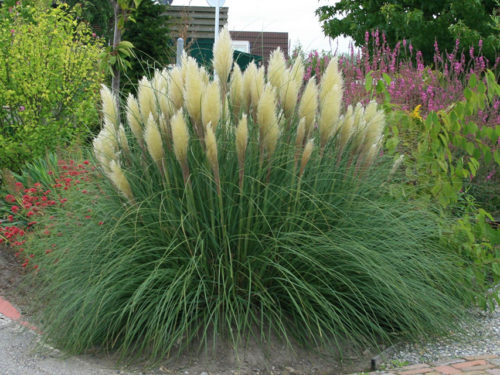
Pampas Grass, Botanical Plant Description
- Cortaeeria or Pampas Grass is a high plant reaching height to 3 meters. The plant quickly grows, forming large thickened bushes (turfs). Steel plants straight and high.
- Evergreen Leaves of Pampas Grass Long (up to 2 m), thin (1-1.5 cm), with a very sharp tip, which can even be painful. Coloring of the leaves of bluish-green and sizo-silver shades. On the touch of the leaves, the root of the currency is located at the root. Often, the long leaves of the Cortadery begin to bend under their own weight, giving Kurtin even more decorative, rounded view.
- Flowers are assembled several pieces in spikelets, which, in turn, form a thick lush inflorescence. The length of the floweros is about 2-3 m, and the size of the pan can reach from 20 to 50 cm. The flowers are always highly towering over the trees of grass, giving the blooming perennial a very unusual and attractive look.
- Pampas grass - a two-walled plant with representatives of ooo flowers. Women's inflorescences look more attractive at the expense of special compactness and pomp. Plants with male flowers are slightly loose and less fluffy metels. The color of the inflorescence varies depending on the type. Most often there are SIZO - white or yellowish flowers, although there are blizzards of red, bright pink or lilac-lilac shades. Flowers grass long: from August to the most frosts.
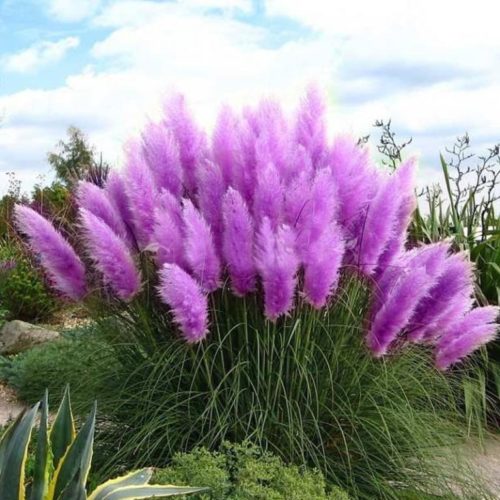
Pampace grass, application of plants
- The flower of the praasnaya grass is grown in culture as an interesting decorative culture, capable of originally to issue a spacious landscape area. Cortaeeria is spectacular and winning as a single accent landing, as a dominant soliter. In group plantings, the perennial looks no less attractive, forming an unusual high alive fence. The blooming bush of Cortadery's water, near the garden pond or an artificial reservoir looks especially nice. Flowering blizzes are picturesquely reflected on the water stroit and create an unusually beautiful and cozy natural landscape.
- The grass is also perfectly combined with other plants: cereal cultures, Valerian, Dolphinium, Miscantus, Labaznik, Niesen, and others. Often, tall cortadery or pampas grass is used for the country area as designing the back plan or creating a multi-level alpine slide.
- The original plant-exotic with lush silver belts in the fall looks especially spectacular and winning against the background of yellowing foliage of garden trees.
- Landscape designers apply the landing of pampas grass as a plant that allows you to set expressive vertical lines to the landscape. Growing the overall pampas grass provides for the presence of a spacious open area. In small areas or compact flower beds, a similar spreading perennial will look inappropriate and cumbersome.
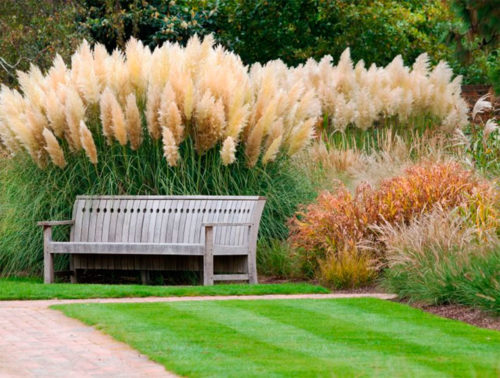
- Pampas grass can be easily raised at home. To do this, only you will need large floral bags and free space in the house. For the summer, pots with a plant are recommended to exhibit outside, in the garden.
- At the same time, in some countries (in New Zealand, South Africa, Spain, etc.), the plant is recognized as weed grass to be destroyed. Such an attitude to cereal culture is due to the ability of the plant to the rapid distribution and displacement of other plants, so in these regions to remove the cerebral so-called. Chemical weeding. Such aggressive "behavior" is manifested only in climatic zones most favorable for the growth and development of perennial. In our country, the cold and frosty winter is a restraining factor in the spread of grass in the area, so such a problem does not threaten our flowerfish.
- Cortadery, like most of her cereal "relatives", is used on cattle.
- In the homeland, in South America, paper is made from the leaf of pampas grass.
- Dried metels of perennials are used to create floristic compositions or dry bouquets.
Pampas grass, varieties and varieties
As a decorative plant, the Pampas Grass was known in Europe back in 1837, when an unusual Zlak was planted in the Gardens of Queen Victoria.
Currently, more than 25 species of perennial and twice the grades are highlighted by breeders.
Classifying the corortion of inflorescence color, the following varietal groups of plants can be distinguished.
Pampas grass varieties with white and silver inflorescences
- The "Pumila SunningDale Silver" grade grows up to 3 m, "throws out" high blur pains with silver painted inflorescences.
- Montstrosa variety reaches a height of about 2.5 - 3 m, has large whitish inflorescences with a light shade of yellow color, the leaves of the jet-green.
- Sort "Patagonia", up to 2.4 m high, with silver-yellowish inflorescences. Blossom Later, leaves have a beautiful bluish tint. Foldful grade.
- The "White Feather" grade is growing no more than 2 m, blooms with white lush inflorescences.
- The Silver variety is a relatively low grass, a height of 1.5-2.1 m, has cream inflorescences, the bloom comes early.
- Sort "Senor" reaches a height of about 1.8 m, has blessed inflorescences.
- Grade "Evita" - from 1.2 to 1.7 m, with silver-yellowish inflorescences. It is characterized by early blossoms.
- Grade "Liliput" - a low-speed variety of pampas grass, growing no higher than 1-1.5 m. Differs in white inflorescences and debris-green leaves.

Pampas Grass Varieties with Pink Inflorescences
- SUNNINGDALE SILVER HIGHFIELD PINK - a tall variety, reaching 2.5-3.5 m, blooms with gentle pale pink inflorescences.
- The CARMINEA RENDATLERI variety reaches a height of 2.5-3.6 m, has pink inflorescences and direct high stems.
- The SCARLET Wonder variety is growing up to 2.5-3 m, has the inflorescences of a red shade.
- The "RENDATLERI" variety is characterized by beautiful lilac inflorescences, the height of the plant is 2.5-2.7 m.
- The "Pink Feather" variety, Rosa Feder grows no higher than 2.5 m, blooms with pink inflorescences.
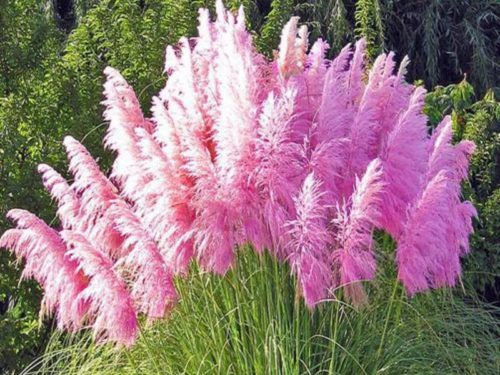
Pampas grass varieties with whiten striped leaves
- SILVER COMET grade grows up to 2.5 m, "ejects" silver inflorescences and cream striped leaves.
- The "NotCort" variety reaches about 2 m in height, is characterized by creamy white narrow leaves.
- The Albolineata variety is 1.5-2 m high, light foliage color borders white edging. The variety is relatively slow growth.
- Variety "Ice Cool" - a relatively low variety of cereal (1.5-1.8 m), blooms late, leaves with whiten fields.
Pampas grass varieties with yellow striped leaves
- The Golden Goblin variety reaches a height of no more than 1.5 m, blooms early, white flowers. Leaves decorate a central yellow strip.
- The MOVIN grade grows in the range of 1.2-1.5 m, silver-whitty inflorescences, white leaves with a yellow stripe in the middle.
- The grade "Golden Fantasy" is one of the lowest (1-1,5 m), silvery inflorescences, bright leaves, with yellow edges and stripes.
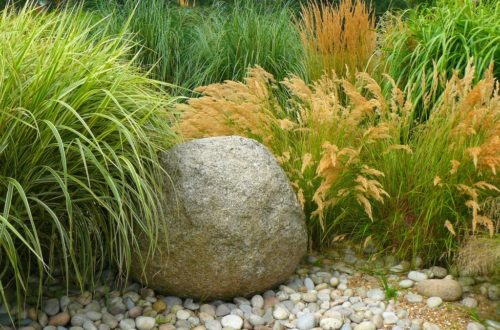
Where to buy pampas grass?
- You can buy a pampas grass in any specialized store, a vegetable nursery or a proven online sale. Cortadery planting material can be sold in the form of seedlings or seeds of perennial grass.
- By purchasing seedlings of cereal culture, attention should be paid to the sex form of the proposed plant. Women's specimens have increased decorativeness, which is not losing even in the period of rain. Male plants are distinguished by more loose metels, which with the onset of autumn will noticeably dump and lose attractiveness.
- Buying Cortadery Seeds does not always be 100% guaranteed by the sexual and varietal belonging of the plant.
- According to the reviews of many flowerflowers, the pampas grass is absolutely not a capricious plant, which is pretty quickly leaving in a new place.
Planting pampas grass
Pampas herb is considered an unpretentious hardy culture, the landing of which does not cause special problems. Meanwhile, to grow in its plot, a chic and well-developed corn bush should take into account some features of planting and choosing a place for many years of culture.
In the regions with a temperate climate, Cortadery smells to the open ground, without fear of winter frosts. But as for the regions of risky agriculture, the pampas grass is better grown in bulk containers, which for the winter is transferred to the room.
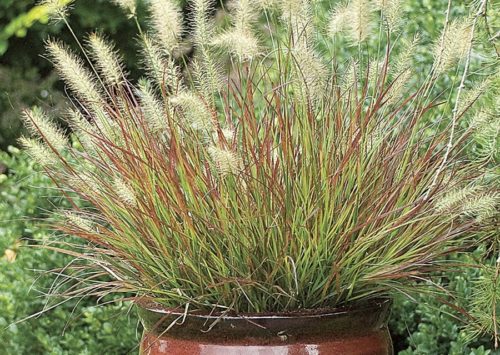
Time and Place of Pampas Grass
- When selecting a plot for landing for pampass grass, it is important to take into account the preferences of cereal culture. Cortadery needs sunny areas closed from drafts and gusty winds, with fertile, loose and breathable soil. Although, by and large, the plant can grow almost in any conditions, with different types of soil. The exception is too shaded and wetlands. From the amount of sunlight will directly depend on the decorativeness of the pampass grass.
- Successful will landing the Cortadery near the stony buildings. Such a neighborhood will have significant benefit to the plant, since the stones are able to "give" the accumulated heat, which thus optimizing the development of the curtain.
- Young chicks of pampas grass is best planted in the spring, in the second half of March. It is not worth tightening with the dates of landing, giving the opportunity to the seedlings to root in a new place before the active growing season.
- If the seedlings were purchased in the fall, it is better to preserve them to spring, providing plants moderate watering and a reduced temperature of content. Autumn planting of the plant risks to become in vain, since the risk of freezing the young rapid cereal is great.

Agrotechnical landing of pampas grass
You can plant pampas grass in two ways: putting seedlings or sowing the seeds of the cereal.
- Planting the seedlings of pampas grass involves preliminary training of landing pit. The width of the pit should be on 1 \\ 3 part wider volume of the root plant of the plant.
- immediately before planting on the bottom of the pits, the drainage layer of pebbles, fine gravel, broken brick or sand are poured. A fertile soil (with the addition of peat, manure or compost) fall over over the drainage;
- when landing, Kortadery's bustard is not plugged, so as not to provoke the platter;
- in a temperate climate, when planting a plant, it is better to take care of the artificial plant growth limiters in advance. For this, the old sheets of iron or slate, which prevent the proliferation of the Cortadery on the site, are bought around the landing pit. In addition to these measures, in the spring you can additionally chop the crossed roots of many years of cereal.
- hut down several seedlings of pampas grass, leave the interval of 1.5-2 m between the instances of the plant. Such a distance must be withstanding with the subsequent active growing of the curtain of the curtain;
- after planting a well with a plant is abundantly watered with water.
- In addition to planting seedlings, the pampas grass can be seen by seeds. Sowing seeds as well as seedlings, spend early spring. Although autumn seed landing is possible in greenhouse conditions. Naturally, a pampas grass grown from seeds blooms much later (after 5-6 years) than essential seedlings.
- pampas herbs seeds can be bought in the store or apply to independently from an adult plant;
- before landing the seeds of many years of grass into the ground, they must pass the stratification procedure. For this, the seed material is placed in the refrigeration chamber for 1-2 months;
- cortadery seeds are characterized by a good germination, but before sowing them it is better to "go" in a weak solution of potassium permanganate (manganese);
- seed seed first into the container with soil substrate, and then (about a month later) plant seedlings are planted into open ground;
- small seeds do not plunge, but simply lay out on the surface, slightly pressing into the substrate. The container is covered with glass or film, imitating favorable greenhouse conditions for germination of seed;
- for successful germination of planting material, the container is placed in warm (not lower than 18-20 0C) Light place (at least 8 hours), providing regular soil irrigation. The first shoots appear in about 2 weeks;
- the plant is transplanted into open soil when the seedlings reach a height of 15-20 cm. If at the time of the germination of seedlings the weather is not yet consistently positive, - with the planting seedlings of pampas grass in the ground, it is better to pay it better;
- cortadery's seedlings are best replant with a translated method, maintaining an earthen car around the seedlings.
Pampas Herb, Care Rules
Pampasnaya Grass is considered absolutely unpretentious and lively culture. And although at home, the plant is often associated with an aggressive weed, in our territories, the grass of the pampas is not prone to such a quick distribution. This is due to harsh cold winters, which are a natural deterrent factor in the uncontrolled reproduction of a thermal-humid culture.
Cortaeeria is practically not subjected to pest attacks and is completely indifferent to diseases. Such advantages greatly facilitate the care of the perennial, which is practically no additional attention.
The only inconvenience when leaving the grass is sharp hard leaves that can be cut. Therefore, you should not land a pampas "Beauty" near the garden tracks or near the places where children can play. When working with a plant, use gloves and protect your eyes.
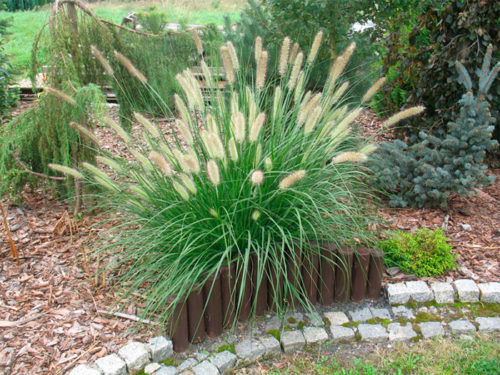
Watering, looping of pampas grass
- Universal unpretentious culture, corortary, easily tolerate both drought and increased humidity. A powerful and deep root system is able to "produce" water in the lowest soil layer.
- At the same time, the pampas grass has favorably reacts to regular watering. It is especially important to moisturize the soil in the summer period of active vegetation and the growth of green mass.
- As for the norm of irrigation, the larger the Cortadery bush, the more moisture it needs. On average, an adult plant consumes about 1-2 buckets of water every week. With prolonged arid weather, the amount of irrigation increases.

Making fertilizers and feeding of pampas grass
- In early spring, complex mineral fertilizers contribute to the ground.
- During the period of active vegetation, in summer, cereal culture can be filing with nitrogen-containing fertilizers, stimulating the growth of green mass.
- The blurred inflorescences of the pampas grass for a long time retain their decorative look, so it's not worth cutting them immediately after flowering.
Trimming Pampas Herb
- To preserve an attractive decorative view of the curtain, in the spring it is trimmed by pampas grass.
- During the trimming, old leaves remove so that they do not climb the bush, as well as the blurred dry scenery.
- During the pruning period, Cortadery turns give a neat, rounded view. The trimming is carried out in gloves so as not to cut hands on the sharp edges of the leaf of the cereal plant.
Fighting pests and diseases of pampas grass
- Occasionally, the plant may be affected by such diseases as anthracnose or mildew. In the event of signs of the disease, all affected areas are removed, and the bush itself is treated with a fungicidal solution.
- Dry hot weather can provoke the appearance of such insect pests on the leaf leaves of the pampas grass, like a wave and web tick. Insecticidal preparations will be useful to combat parasites.
Wintering pampas grass
- The native of the tropics, the pampas grass is distinguished by low frost resistance. Therefore, in the regions with cold winters, the perennial for winter must be prepared in advance.
- In the areas of risky agriculture, the pampas grass thoroughly insulate for the winter, building a special grid or wooden frame, which is filled with hay or straw. From above, such a structure is closed with a film or any observer material. An alternative to such insulation will be the cultivation of Cortadery in large floral vases, which simply enter the winter to the room.
- As for regions with a temperate mild climate, problems with wintering pampas grass there practically does not occur. It is enough to cut a bush by 30-40 cm, to tie it with a twine and fall asleep the rolling circle with dry leaves.
- Choosing at the landing of one or another variety of pampas grass, it is important to take into account the climatic conditions of the area and the level of frost-resistant plants. So, it is known that the pink blooming of the Cortadery blizzard is more sensitive to the cold, rather than her white varieties.
- In addition to low temperatures, the pampas grass in winter can suffer from high soil moisture. Mulching of soil with sawdust or wood bark will help maintain the optimal level of humidity.
- Hold down the grass for the winter follows during the first frost. Early shelter in the fall can provoke the metering and development of mold on the plant. Later shelter is fraught with the frozen of many years of culture.
Pampas grass reproduction
Pampas grass reproduction is carried out by dividing the bush or with seeds.
- The division of the bush is the simplest and most affordable method of breeding cereal culture. At the same time, the methods of young bushes of herbs quickly come out in a new place and after a few seasons begin to bloom. The separation of the bush on parts (with pieces of root) is carried out in spring or autumn with the help of a shovel. During the separation of the part of the turf, the entire bush dig up optionally.
- Cortadery seeds are sown in an open soil or, more preferable to a container with a soil mixture for growing a seedliness. Step-by-step agrotechnology of planting seeds and the cultivation of seedlings is described above (in the section "Agrotechnology planting a pampas grass").
Thus, a beautiful plant with thin cigraial leaves and fluffy bright inflorescences - belties can grow in their plot anyone, even a novice flower model. Pampas Grass will be a real "highlight" on the background of the familiar flowering plants and shrubs. At the same time, many years of cereals will not require special attention or very difficult care. Elementary agrotechnical techniques and selection of the right place for landing are the key points of successful cultivation of exotic pampas grass.

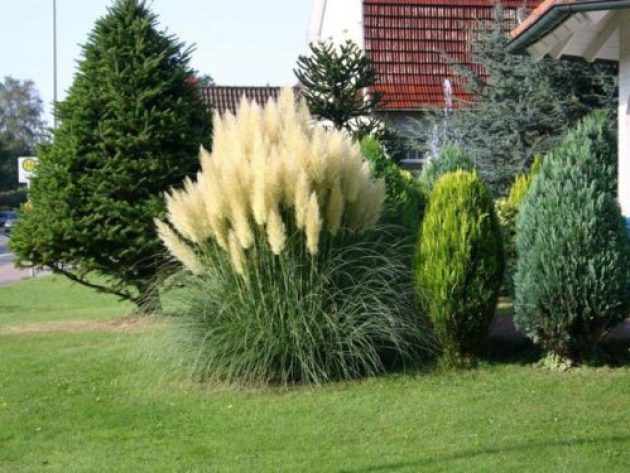
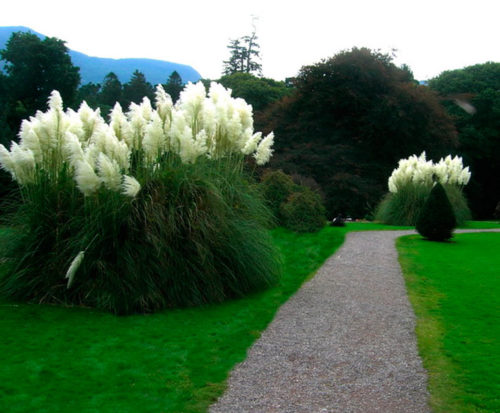




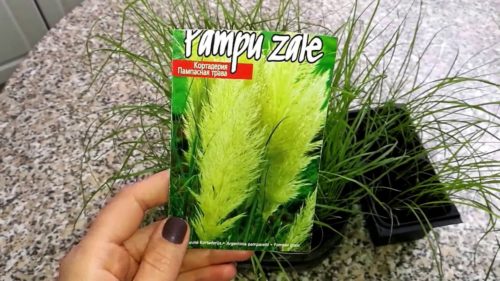
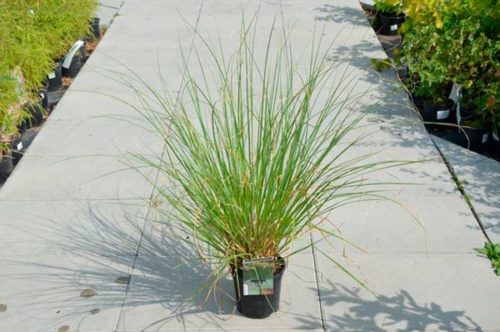







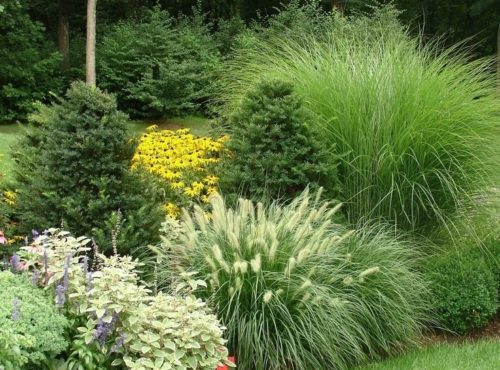

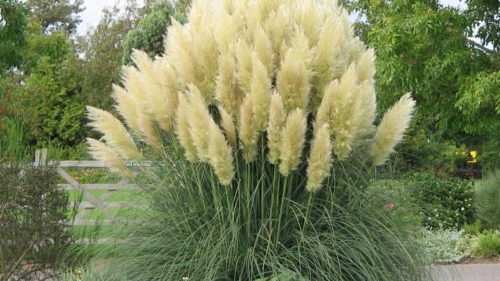

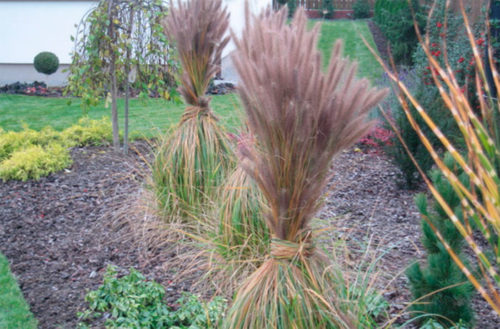

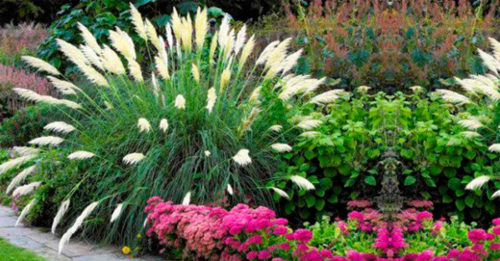












 Start a discussion ...
Start a discussion ...